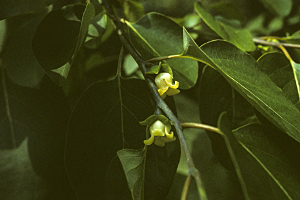Diospyros virginiana grows wild but is also cultivated for the fruit and wood. It has also been used as an ornamental in landscaping and for erosion control because it tends to have a deep taproot. Common persimmon is native to the U.S. and is in the Ebenaceae (Ebony Family).
Photo Credit: © G.A. Cooper. Courtesy of Smithsonian Institution.
Diospyros virginiana
Common Name: common persimmon
Plant Functional Group: Deciduous broadleaf
Class > Order > Family: Magnoliopsida > Ericales > Ebenaceae
What does the species look like?
Diospyros virginiana is a perennial, deciduous tree that can grow to 70 feet in height. The bark is dark to black and has a distinctive square block pattern. The foliage is glossy, leathery, and dark green in summer. In fall, it may be yellow or reddish- purple. Buds are reddish-black with overlapping scales. Common persimmon is dioecious, with male and female flowers on different plants. Both male and female flowers are bell-shaped and creamy white to yellow. The fruit is an edible berry usually round and orange to purplish in color when ripe and contains several small, brown seeds. The orange fruit is pollinated by insects, wind, and water, and by the birds and wildlife that eat it.
Common persimmon prefers a humid climate and full sun but tolerates shade. It also has a high tolerance to drought. It prefers well-drained soil but can grow in almost any type of soil. Common persimmon can be found growing in bottomland swamps; along stream banks and upland forests; and on roadsides, pastures, and old fields. Common persimmon is a larval host plant for the luna moth. Many species of birds and wildlife enjoy the fruit for food. Deer browse on the sprouts, but cattle don’t graze as much. The flowers attract bees.
Where is the species found?
States & Provinces
AL, AR, CA, CT, DC, DE, FL, GA, IA, IL, IN, KS, KY, LA, MA, MD, MO, MS, NC, NE, NJ, NY, OH, OK, PA, SC, TN, TX, UT, VA, WV
Special Considerations for Observing
If drought seems to be the cause of leaf color or fall for a plant, please make a comment about it for that observation.
This species has separate male and female flowers. If you know whether the flowers you are observing are male or female (or both), please make a comment about it for that observation.
Which phenophases should I observe?
Do you see...?
Leaves
Breaking leaf buds More...
How many buds are breaking?
Less than 3 3 to 10 11 to 100 101 to 1,000 1,001 to 10,000 More than 10,000
Leaves More...
What percentage of the potential canopy space is full with leaves? Ignore dead branches in your estimate of potential canopy space.
Less than 5% 5-24% 25-49% 50-74% 75-94% 95% or more
Increasing leaf size More...
What percentage of full size are most leaves?
Less than 25% 25-49% 50-74% 75-94% 95% or more
Colored leaves More...
What percentage of the potential canopy space is full with non-green leaf color? Ignore dead branches in your estimate of potential canopy space.
Less than 5% 5-24% 25-49% 50-74% 75-94% 95% or more
Falling leaves More...
Flowers
Flowers or flower buds More...
How many flowers and flower buds are present? For species in which individual flowers are clustered in flower heads, spikes or catkins (inflorescences), simply estimate the number of flower heads, spikes or catkins and not the number of individual flowers.
Less than 3 3 to 10 11 to 100 101 to 1,000 1,001 to 10,000 More than 10,000
Open flowers More...
What percentage of all fresh flowers (buds plus unopened plus open) on the plant are open? For species in which individual flowers are clustered in flower heads, spikes or catkins (inflorescences), estimate the percentage of all individual flowers that are open.
Less than 5% 5-24% 25-49% 50-74% 75-94% 95% or more
Fruits
Fruits Diospyros virginiana , the fruit is a fleshy "persimmon" that changes from green to yellow, orange or dark red.More...
How many fruits are present?
Less than 3 3 to 10 11 to 100 101 to 1,000 1,001 to 10,000 More than 10,000
Ripe fruits Diospyros virginiana , a fruit is considered ripe when it has turned yellow, orange or dark red.More...
What percentage of all fruits (unripe plus ripe) on the plant are ripe?
Less than 5% 5-24% 25-49% 50-74% 75-94% 95% or more
Recent fruit or seed drop More...
How many mature fruits have dropped seeds or have completely dropped or been removed from the plant since your last visit?
Less than 3 3 to 10 11 to 100 101 to 1,000 1,001 to 10,000 More than 10,000
What do these phenophases look like?
There is currently no photoguide available for this species. If you'd like help us create one, use the guidance document and species template provided here . Then send it via email to education@usanpn.org when it is complete.
